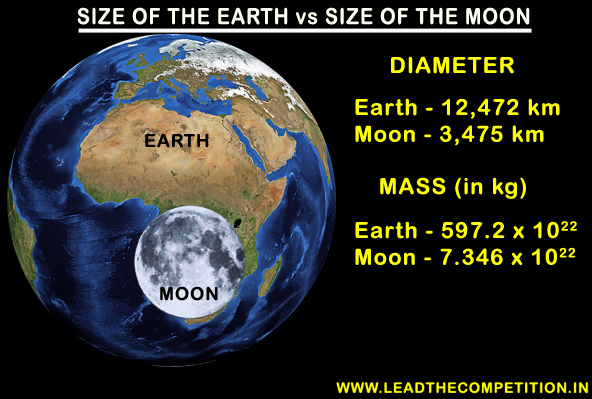Facts about Moon
- The diameter of the moon is about 3,475 km which is less than one-third of earth's diameter.
- The temperature on the moon varies from – 100° C (on the dark side) to + 130° C (with the sun shining)
- The moon takes 27.33 days to orbit the earth. Its rotation period is also the same approximately.
- Since the period of rotation of the moon around its axis and the time taken by it to revolved round the earth is the same approximately we see the same side of the moon from the earth.
- Only about 59% percentage of the moon is visible from the earth.
- The gravity on the moon is about one-sixth (1/6) of that of the earth. Thus a person weighing 60 kg on earth would weigh about 10 kg on the moon.
- The moon has no atmosphere, and hence no sound can be heard on the Moon, and the sky always appears black.
- The moon is at an average distance of 384,000 km from the earth. (The speed of light is 300,000 km per second)
- While United States of America is the only country to have sent a manned mission to moon, unmanned missions to the moon have been sent by USA, USSR, China, Japan, Israel and India.

Features on Lunar Surface
| Name | Remarks |
|---|---|
| Mare Tranquillitatis or Sea of Tranquility | Landing site for Apollo 11, the first manned landing on the moon. |
| Oceanus Procellarum or Ocean of Storms | Apollo 12 landed with Pete Conrad and Alan Bean onboard. |
| Mare Fecunditatis or Sea of Fertility | Landing site for Luna 16 of USSR. |
| Fra Mauro - crater | Apollo 14 landed with Alan B. Shepard, Jr., Edgar D. Mitchell and Stuart A. Roosa. |
| Hadley Rile - Apennine Mountains | Landing site for Apollo 15. |
| Apollonius Highlands - Mountainous region | Landing site for Luna 20 |
| Descartes - crater | Landing site for Apollo 16. |
| Taurus-Littrow - valley | Apollo 17 landing site. |
| Note : 1. Mare or Maria refers to a large circular plain on the moon. 2. Oceanus refers to a very large dark area on moon. 3. Crater is a circular depression. | |